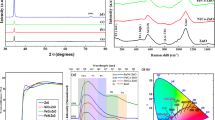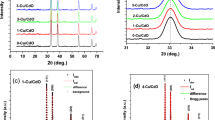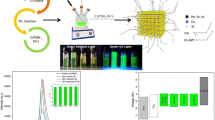Abstract
Sol–gel-derived aluminum (Al)-doped zinc oxide thin films have been deposited on silicon (Si) wafers and microslide glass substrates using the spin coating technique. The atomic ratio of Al:Zn in the films is 0.05, 0.1, 0.2, and 0.3. The films have been characterized using different techniques, i.e., x-ray diffraction, Fourier transform infrared spectroscopy, atomic force microscopy, scanning electron microscopy, UV-visible-near infrared spectrophotometry, spectroscopic ellipsometry, and the four-probe method. The films have exhibited excellent optical transmittance (∼90%). The refractive indices of the films are in the range between 1.47 and 1.53. The thickness of the films is in the range of 103–115 nm. The films have demonstrated reflectivity of about 3% at a wave length of 600 nm. The reflectivity, transmittance, refractive index, and thickness values of the films show that the films are promising candidates for utility as antireflection coatings in silicon solar cells.










Similar content being viewed by others
References
A. Ortız, A. Sanchez, C. Falcony, M.H. Farıas, G.A. Hirata, and L. Cota-Araiza: Lack of chemical interaction of hydrogenated amorphous silicon with indium-doped zinc oxide transparent conductive films. J. Non-Cryst. Solids 103, 9 (1988).
M.A. Martinez, J. Herrero, and M.T. Gutierrez: Deposition of transparent and conductive Al-doped ZnO thin films for photovoltaic solar cells. Sol. Energy Mater. Sol. Cells 45, 75 (1997).
S. Oktik: Low cost, non-vacuum techniques for the preparation of thin/thick films for photovoltaic applications. Prog. Cryst. Growth Charact. Mater. 17, 171 (1988).
J. Zhao, L.Z. Hu, Z.Y. Wang, Y. Zhao, X.P. Liang, and M.T. Wang: High-quality ZnO thin films prepared by low temperature oxidation of metallic Zn. Appl. Surf. Sci. 229, 311 (2004).
P.K. Song, M. Watanabe, M. Kon, A. Mitsui, and Y. Shigesato: Electrical and optical properties of gallium-doped zinc oxide films deposited by dc magnetron sputtering. Thin Solid Films 411, 82 (2002).
J. Hu and R.G. Gordon: Textured fluorine-doped ZnO films by atmospheric pressure chemical vapor deposition and their use in amorphous silicon solar cells. Sol. Cells 30, 437 (1991).
M. Krunks and E. Mellikov: Zinc oxide thin films by the spray pyrolysis method. Thin Solid Films 270, 33 (1995).
T. Schuler and M.A. Aegerter: Optical, electrical and structural properties of sol gel ZnO:Al coatings. Thin Solid Films 351, 125 (1999).
R.E. Marotti, D.N. Guerra, C. Bello, G. Machado, and E.A. Dalchiele: Bandgap energy tuning of electrochemically grown ZnO thin films by thickness and electrodeposition potential. Sol. Energy Mater. Sol. Cells 82, 85 (2004).
O. Kluth, G. Schöpe, J. Hüpkes, C. Agashe, J. Müller, and B. Rech: Modified Thornton model for magnetron sputtered zinc oxide: Film structure and etching behaviour. Thin Solid Films 442, 80 (2003).
S.T. Shishiyanu, T.S. Shishiyanu, and O.I. Lupan: Sensing characteristics of tin-doped ZnO thin films as NO2 gas sensor. Sens. Actuators, B 107, 379 (2005).
E. Suvaci and İ.Ö. Özer: Processing of textured zinc oxide varistors via templated grain growth. J. Eur. Ceram. Soc. 25, 1663 (2005).
T. Meron and G. Markovich: Ferromagnetism in colloidal Mn2+-doped ZnO nanocrystals. J. Phys. Chem. B. 109, 20232 (2005).
S. Liang, H. Sheng, Y. Liu, Z. Huo, Y. Lu, and H. Shen: ZnO Schottky ultraviolet photodetectors. J. Cryst. Growth 225, 110 (2001).
N.W. Emanetoglu, C. Gorla, Y. Liu, S. Liang, and Y. Lu: Epitaxial ZnO piezoelectric thin films for saw filters. Mater. Sci. Semicond. Process. 2, 247 (1999).
N. Saito, H. Haneda, T. Sekiguchi, N. Ohashi, I. Sakaguchi, and K. Koumoto: Low-temperature fabrication of light-emitting zinc oxide micropatterns using self-assembled monolayers. Adv. Mater. 14, 418 (2002).
M.H. Huang, S. Mao, H. Feick, H. Yan, Y. Wu, H. Kind, E. Weber, R. Russo, and P. Yang: Room-temperature ultraviolet nanowire nanolasers. Science 292, 1897 (2001).
S.J. Pearton, D.P. Norton, K. Ip, Y.W. Heo, and T. Steiner: Recent progress in processing and properties of ZnO. Prog. Mater. Sci. 50, 293 (2005).
M. Hiramatsu, K. Imaeda, N. Horio, and M. Nawata: Transparent conducting ZnO thin films prepared by XeCl excimer laser ablation. J. Vac. Sci. Technol., A 16, 669 (1998).
M. Joseph, H. Tabata, and T. Kawai: Ferroelectric behavior of Li-doped ZnO thin films on Si(100) by pulsed laser deposition. Appl. Phys. Lett. 74, 2534 (1999).
Z.Q. Xu, H. Deng, Y. Li, and H. Cheng: Al-doping effects on structure, electrical and optical properties of c-axis-orientated ZnO:Al thin films. Mater. Sci. Semicond. Process. 9, 132 (2006).
S.Y. Kuo, W.C. Chen, F.I. Lai, C.P. Cheng, H.C. Kuo, S.C. Wang, and W.F. Hsieh: Effects of doping concentration and annealing temperature on properties of highly-oriented Al-doped ZnO films. J. Cryst. Growth 287, 78 (2006).
A. Verma, F. Khan, D. Kumar, M. Kar, B.C. Chakravarty, S.N. Singh, and M. Husain: Sol–gel derived aluminum doped zinc oxide for application as anti-reflection coating in terrestrial silicon solar cells. Thin Solid Films 518, 2649 (2010).
Acknowledgments
Financial support from Council of Scientific & Industrial Research (AV) is gratefully acknowledged. The authors also wish to thank Dr. S.K. Srivastava for electrical measurements.
Author information
Authors and Affiliations
Corresponding author
Rights and permissions
About this article
Cite this article
Verma, A., Vijayan, N. Sol–gel-derived nanocrystalline aluminum-doped zinc oxide thin films for use as antireflection coatings in silicon solar cells. Journal of Materials Research 28, 2990–2995 (2013). https://doi.org/10.1557/jmr.2013.273
Received:
Accepted:
Published:
Issue Date:
DOI: https://doi.org/10.1557/jmr.2013.273




